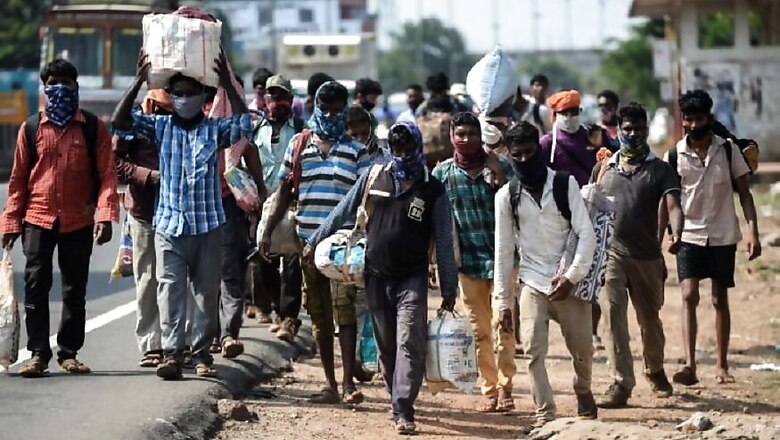
views
State governments, in competition to attract foreign investment, have eased regulations vis-a-vis the two big imperatives: land and labour. The knee-jerk measures are justified on the grounds of job creation, that is, converting India's 'youth bulge' into a demographic dividend.
The dilution of protective labour legislation has been welcomed by industry bodies, on the premise that these laws hurt the workers they are supposed to protect, by pushing them into informal employment.
Are labour reforms oriented towards highly competitive MNCs the best way forward for India in the wake of the pandemic? Any why has the Centre allowed the states to muddle its ongoing effort to rationalise labour laws?
The ad hocism by the states runs counter to the move towards an overarching legal framework in the form of four labour codes which will subsume India's 44 central and 387 state labour laws (not to mention some 27,000 labour compliances).
They have adopted different approaches, suspending or modifying existing laws to extend hours of work, permit hire-and-fire, eliminate cumbersome inspections and so on. Uttar Pradesh, for example, has suspended all but three of its 38 labour laws.
But several of those laws don't apply any more, having been subsumed by the Code on Wages 2019 – which specifically prohibits extending hours of work without paying overtime or lowering minimum wages below the existing level.
The status of the Code on Industrial Relations is just as confusing. On the one hand, the Centre has issued advisories against non-payment of wages and retrenchment during lockdown. On the other, Parliament's standing committee on labour maintains that in case of natural calamities (such as Covid), paying wages is unjustifed and workers can be laid off, with monetary compensation.
It's not clear whether these are short-term measures and what is in store for India's workers in the long-term. Shrinking the protective legislative umbrella could actually contribute to strengthening the labour movement, by causing more workers to unionise.
A weak labour movement is undesirable, because it enables exploitation and leads to labour unrest, when workers cannot channel their demands through institutionalised grievance redressal mechanisms. On the other hand, Kerala-style labour militancy undermines cooperation with employers and leads to an investor-unfriendly climate.
The ideal is a 'social partnership' between labour unions and employers, such as Germany's 'codetermination (workers' participation in decision-making)' model, which testifies that a strong labour movement and economic progress are not mutually exclusive.
The German example has inspired efforts towards codetermination outside Europe, such as in South Korea. Institutionalized workers' participation in managerial processes is believed to contribute to democratisation of the economy, higher productivity and harmonious industrial relations.
In India, trade unions have preferred collective bargaining over participation. Negotiations with employers are undertaken by union representatives rather than those directly elected by workers and participation has been confined to productivity and welfare-related issues.
Thus, neither employers nor the highly-politicised trade unions have furthered workers' participation in India, despite initiatives by various governments. Codetermination seems further off than ever in the current scenario.
The Centre should have notified rules under the Code of Wages 2019 and speedily passed the remaining three labour codes, to ensure uniformity. Instead, it has backed the states.
Land laws have also been subject to ad hocism by states, which have diluted provisions of the Right to Fair Compensation & Transparency in Land Acquisition, Rehabilitation & Resettlement (LARR) Act 2013, in order to build vast industrial 'land banks'.
Industry bodies (and the World Bank) had red-flagged land acquisition as a major impediment to 'ease of doing business', because the highly fragmented nature of land holdings in India makes it difficult to aggregate land for large projects. Consequently, land banks have become integral to the industrial policies and ease-of-doing-business reforms of state governments.
Behind these land banks lies a troubled history of expropriation, loss of livelihoods and disruption of communities. According to reports, even revenue forest and village commons have been converted for industrial use. Can the number of jobs created compensate for mass displacement?
A public interest litigation challenging the amendments to the LARR Act by various states was filed in the Supreme Court in 2018. Meanwhile, in 2019, the Madras High Court refused to allow the Tamil Nadu government to bypass the LARR Act.
The Centre's stand is clear; itself having failed to dilute the LARR Act through the ordinance route, it supports the states. Draconian land acquisition policies led to farmers' agitations and consequently, the passing of the LARR Act. Turning the clock back will worsen the agrarian crisis and add to joblessness.
Admittedly, job creation is a priority, with a median age of 26.8 years and 5 – 10 million youth joining the workforce annually. A large population of unemployed or under-employed youth is a recipe for social unrest. But ad hoc labour and land policies seem oriented towards making workers and farmers more rather than less vulnerable to livelihood insecurity.




















Comments
0 comment